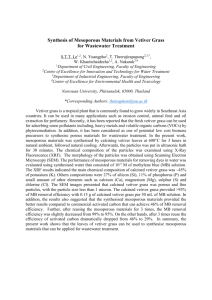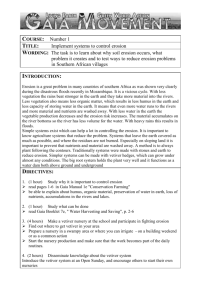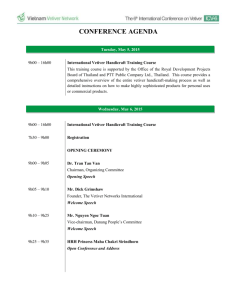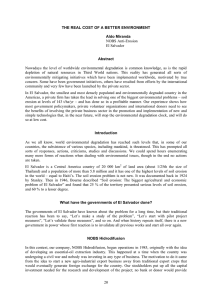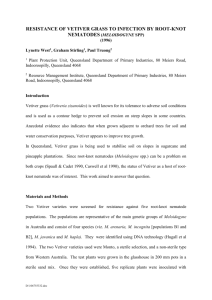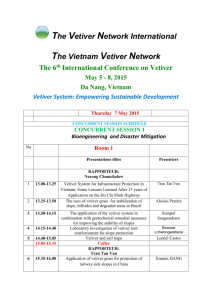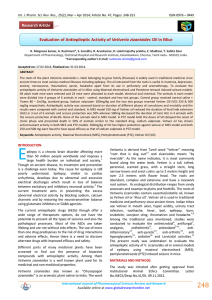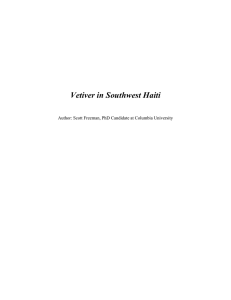Asian Journal of Agricultural Sciences 2(3): 84-88, 2010 ISSN: 2041-3890
advertisement
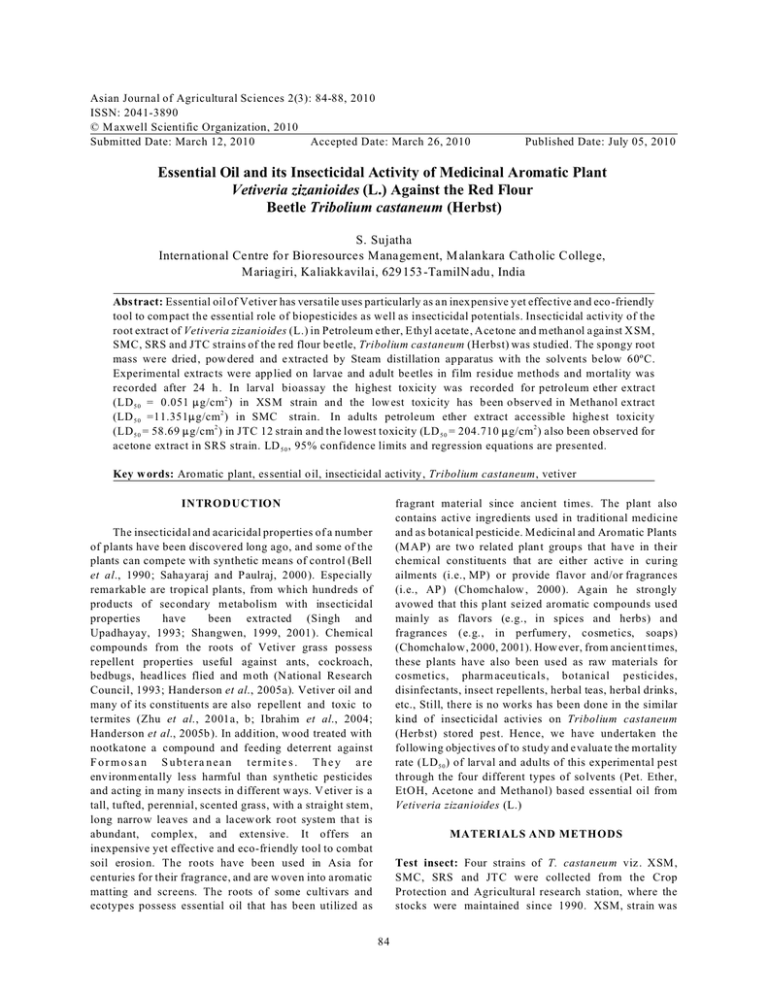
Asian Journal of Agricultural Sciences 2(3): 84-88, 2010 ISSN: 2041-3890 © M axwell Scientific Organization, 2010 Submitted Date: March 12, 2010 Accepted Date: March 26, 2010 Published Date: July 05, 2010 Essential Oil and its Insecticidal Activity of Medicinal Aromatic Plant Vetiveria zizanioides (L.) Against the Red Flour Beetle Tribolium castaneum (Herbst) S. Sujatha International Centre for Bioresources Managem ent, M alankara Cath olic C ollege, Mariagiri, Kaliakkavilai, 629153 -TamilN adu, India Abstract: Essential oil of Vetiver has versatile uses particularly as a n inex pensive yet effective and eco -friendly tool to com pact the esse ntial role of biopesticides as well as insecticidal potentials. Insecticidal activity of the root extract of Vetiveria zizanioides (L.) in Petroleum e ther, Ethyl a ce ta te , A ce tone and methanol a ga inst X SM, SMC, SRS and JTC strains of the red flour beetle, Tribolium castaneum (Herbst) was studied. The spongy root mass were dried, pow dered and extracted by Steam distillation apparatus with the solvents below 60ºC. Experimental extracts were app lied on larvae and adult beetles in film residue methods and mortality was recorded after 24 h . In larval bioassay the highest toxicity was recorded for petroleum ether extract (LD 5 0 = 0.051 :g/cm 2 ) in XS M strain and the low est toxicity has been o bserv ed in M ethanol extract (LD 5 0 =11.351:g/cm 2 ) in SMC strain. In adults petroleum ether extract accessible highe st toxicity (LD 5 0 = 58.69 :g/cm 2 ) in JTC 12 strain and the lowest toxicity (LD 5 0 = 204.710 :g/cm 2 ) also been observed for acetone extract in SRS strain. LD 5 0 , 95% confidence limits and regression equations are presented. Key w ords: Aromatic plant, essential oil, insecticidal activity, Tribolium castaneum, vetiver fragrant material since ancient times. The plant also contains active ingredients used in traditional medicine and as botanical pesticide. M edicinal and Aromatic Plants (M AP) are two related plan t group s that ha ve in their chemical constituents that are either active in curing ailments (i.e., MP) or provide flavor and/or fragrances (i.e., AP) (Chomc halow , 2000 ). Ag ain he strongly avowed that this plant seized aromatic compounds used mainly as flavors (e.g., in spices and herbs) and fragrances (e.g., in perfumery, cosmetics, soaps) (Chomchalow, 2000, 2001). How ever, from ancient times, these plants have also been used as raw materials for cosmetics, pharm aceu ticals, botanical pesticides, disinfectants, insect repellents, herbal teas, herbal drinks, etc., Still, there is no works has been done in the similar kind of insecticidal activies on Tribolium castaneum (Herbst) stored pest. Hence, we have undertaken the following objectives of to study and evalua te the m ortality rate (LD 5 0 ) of larval and adults of this experimental pest through the four different types of so lvents (Pet. Ether, EtOH, Acetone and Methanol) based essential oil from Vetiveria zizanioides (L.) INTRODUCTION The insecticidal and acaricidal properties of a number of plants have been discovered long ago, and some of the plants can compete with synthetic means of control (Bell et al., 1990 ; Saha yaraj and Paulraj, 2000). Espe cially rema rkable are tropical plants, from which hundreds of products of secondary m etabolism with insecticidal properties have been extracted (Singh and Upadhayay, 1993; Shangwen, 1999, 2001). Chemical compounds from the roots of Vetiver grass possess repellent properties useful against ants, cockroach, bedbugs, head lices flied and m oth (N ational Research Council, 1993; Handerson et al., 2005a). Vetiver oil and many of its constituents are also repellent and toxic to termites (Zhu et al., 2001a, b; Ibrahim et al., 2004; Handerson et al., 2005b). In addition, wood treated with nootkatone a compound and feeding deterrent against F o r m o s a n S u b t e r a n e a n t e r m i t e s . T h e y a re environm entally less harmful than synthetic pesticides and acting in many insects in d ifferent w ays. V etiver is a tall, tufted, perennial, scented grass, with a straight stem, long narrow lea ves and a lacew ork root system that is abundant, complex, and extensive. It offers an inexpensive yet effective and eco-friendly tool to combat soil erosion. The roots have been used in Asia for centuries for their fragrance, and are w oven into aromatic matting and screens. The roots of some cultivars and ecotypes possess essential oil that has been utilized as MATERIALS AND METHODS Test insect: Four strains of T. castaneum viz . XSM, SMC, SRS and JTC w ere collected from the Crop Protection and Agricultural research station, where the stocks were maintained since 1990. XSM, strain was 84 Asian J. Agr. Sci., 2(3): 84-88, 2010 origina lly collected from flourmills at and other three strains were collected from Crop Protection Lab., Department of Agriculture and enviro nme ntal Science. Mass cultures were maintained in glass jars (1000 mL) and subcultures were in beakers (500 mL) with food medium and kept in an incuba tor at 30±0.5ºC . A standard mixture of whole-w heat flour with pow dered dry ye ast in a ratio of 15:5 was used as food medium throughout the experimental period. uniformly the whole area of the petridish. A fter air dried four plastic rings (30 mm diam) were placed inside the petridish and 10 adult beetles were released within each ring. The rings within the petridish were served as replications. The do ses we re chosen after an ad-hoc bioassay done before the actual experiments. The doses for XSM -1, SM C-2 and SRS-3 strains were similar and they were 4367.99, 436.79, 43.68 and 4.37 :g/cm 2 for petroleum ether extract; 5497.95, 549.80, 54.98 and 5.50 :g/cm 2 for Ethyl Acetate extract, 3746.64, 374.66, 37.47 and 3.75 :g/cm 2 for Acetone extract; and 2343.98, 234.40, 23.44 and 2.34 :g/cm 2 for Methanol extract. In case of JTC-4 strain the doses were 10060.30, 1006.03, 100.60 and 10.06 :g/cm 2 ; 14147.52, 1414.75, 141.48 and 14.15 :g/cm 2 ; 12268.60, 1226.86, 122.69 and 12.27 :g/cm 2 ; and it w as 3109.08, 310 .91, 31.09 and 3.11:g/cm 2 in the same orders of extractions respectively. Larval and adult mortality was recorded after 24 h of treatment. The mortality percentage was corrected using Abb ott’s formu la (Abbott, 1925). The observed data was subjected to Probit analysis. Production of vetiver oil: Spongy root mass of c ertain cultivars of Vetiveria zizanioides contains trace amount of essential or volatile oil, known as vetiver oil or ‘khus oil’, which can be extracted by steam distillation. The dried roots, after washing and drying, can be distilled immediately, or are stored for 12-24 months so enzy matic process can increase oil yield. The process of distillation consists of soaking the root mass prior to packing in the distillation unit, and steam is allowed to pass through for a period of six hours or more. The steam distillation produces around 0.3-1.0% of oil although higher percentages can also be obtained. A resinoid is also produced by solvent extraction for perfumery work. The principal constituents include vetiverol, vetivone, khusimone, khusitone, terpenes (e.g., vetivenes), and sesquiterpenoids. Its chemical compounds were reviewed by Fuehrer (1970). Distillation is long and involves high pressure using water and steam distillation method. RESULTS The calculated LD 5 0 , 95% confidence limits and regression equa tions are presented in Table 1. In larval bioassay the LD 5 0 of petroleum ether extract of roots were 0.051, 0.024, 0.045 and 0.071 :g/cm 2 for XSM, SMC, SRC and JTC 12 strains respectively, which are lowest in comparison to the other extracts. Thus, it proved to be the most toxic to T. castaneum larvae. The methanolic extract was least toxic for XSM (LD 5 0 = 4.187 :g/cm 2 ) and SRC (LD 5 0 = 11.351:g/cm 2 ) strains, whereas for SMC the lowest toxicity was recorded in acetonic (LD 5 0 = 0.339 :g/cm 2 ) and for JTC strain in ethyl acetate (LD 5 0 = 10.580 :g/cm 2 ) extracts. In adult bioassa y aga in petroleum spirit extract was the most toxic (LD 5 0 is 198.57, 31 6.85, 85.46 and 58.77 :g/cm 2 for XSM, CR1, FSS II and CTC 12 strains respectively). The acetonic extract was least toxic for XSM (LD 5 0 = 1000.40 :g/cm 2 ), JTC (LD 5 0 = 306.57 :g/cm 2 ) and JTC (LD 5 0 = 279.13 :g/cm 2 ) strains. In case of SRC ethyl acetate extract w as the least toxic (LD 5 0 = 383.01 :g/cm 2 ). Four solvents extracted compounds and their toxicity also acted differe ntly on strains of T. castaneu m. For larvae the LD 5 0 is more or less uniform in petroleum ether extract of the spongy roots of Vetiveria zizanioides (L.). Ethyl acetate and acetonic extracts showed a slight and methanolic extarct in some cases showed major variation in toxicity with the strains. In adu lts toxicity varied widely with the strains of beetle used. This could be due to the resistance capability of the strains to plant extracts. The insignificant x 2 values for the regression coefficients suggest no heterogeneity of the data. Oil extraction: Freshly prepared Vetiver oil were mixed with following procedure Extractions were done in a Soxhlet’s apparatus with four solvents using the process described by Mchmet and Hakki (2004) and Harborne (1998) below 60ºC. The solvents w ere petroleum ether, ethyl acetate, and methanol used serially on the sam e stock of spongy root in vetiver. After com pleting extraction, the mixed solvent was removed from the extract with a vacu um rotary evaporator. M ortality assay: Film residue method (Busvine, 1971) was used to test the mortality of the larvae and adults of T. castaneum. The extracted materials were weighed and dissolved in acetone for dosing. For larval bioassay the experiments were done in glass vials (10 mL, 2.7 mm dia.) in which 0.2 mL of each dose was dropped and airdried. Then 2.0 g of food was add ed and ten first instar larvae were released in each vial in four replicates for each dose. A control batch was maintained with the same number of larvae. The doses for all strains were similar and they were 48.530, 4.853, 0.485 and 0.048 :g/cm 2 for petroleum ether extract, 61.080, 6.108, 0.610 and 0.061 :g/cm 2 for ethyl acetate extract, 41.63, 4.163, 0.416 and 0.041 :g/cm 2 for acetonic extract, and 26.04, 2.604, 0.260 and 0.026 :g/cm 2 for methanolic extracts. Adult bioassays we re done in petridishes (90 mm). One ml of each dose was dropped separately, covering 85 Asian J. Agr. Sci., 2(3): 84-88, 2010 Tab le 1: LD 5 0 , 95% confidence limits, regression equations and experimental values of the Vetiver essential oil extract in different solv ents treated on larvae and a dults of T. castaneum Various strains Solvent(s) LD 5 0 :g/cm 2 95% CL Up per lim it Regression equations X 2 df Larval bioassay XSM Pet. Ether 0.051 0.006 Y = 4.7354+0.54558X 0.769( 2) E tO H 0.632 0.150 Y = 3.6248+0.76372X 1.342 (2) Acetone 0.591 0.315 Y = 3.7375+0.71240X 0.462 (2) Methanol 4.187 0.285 Y = 3.3092+0.64873X 0.625 (2) SMC Pet. Ether 0.024 0.004 Y = 4.7878+0.54786X 1.108 (2) E tO H 0.041 0.130 Y = 4.6719+0.5334X 1.095 (2) Acetone 0.339 0.202 Y = 3.9432+0.7443 X 0.214 (2) Methanol 0.071 0.008 Y = 4.4077+0.6942X 0.262 (2) SRC Pet. Ethe r. 0.045 0.012 Y = 4.6040+0.6072X 0.082 (2) E tO H 0.398 0.167 Y = 4.0214+0.6113X 0.696 (2) Acetone 0.115 0.163 Y = 4.3621+0.6019X 1.392 (2) Methanol 11.351 0.040 Y = 3.6589+0.41961X 0.503 (2) JTC Pet. Ethe r. 0.071 0.213 Y = 4.45160+0.6506X 0.130 (2) E tO H 0.760 2.683 Y = 4.5592+0.2761X 0.338 (2) Acetone 1.200 0.285 Y = 4.4127+0.5995X 0.072 (2) Methanol 10.580 0.110 Y = 4.8933+0.4519X 0.437 (2) Adult Bioassay XSM Pet. Ethe r. 85.46 339.735 Y = 2.0045+1.3035X 1.235 (1) E tO H 1947.52 960.681 Y = 0.9501+1.4524 X 2.857 (1) Acetone 389.09 799.358 Y = 1.7822+1.0725X 3.371 (1) Methanol 326.33 213.741 Y = 1.9832+1.41558X 3.008 (1) SMC Pet. Ethe r. 175.067 573.474 Y = 2.3069+1.07685X 1.719 (1) E tO H 1892.606 4252.741 Y = -1.1179+1.7718X 3.062 (1) Acetone 7148.368 6776.66 Y = 0.8865+0.94725X 1.205 (1) Methanol 31.859 1351.006 Y = 3.0606+0.83701X 3.517 (1) SRC Pet.Ethe r. 56.6137 129.008 Y = 1.6968+1.70991X 1.810 (1) E tO H 383.01 990.901 Y = 2.3492+0.80584X 0.522 (1) Acetone 97.788 1547.731 Y = 1.51261+1.3464X 3.634 (1) Methanol 177.626 599.527 Y = 2.61212+0.9499X 2.671 (1) JTC Pet. Ethe r. 37.788 98.060 Y = 2.86467+1.2069X 3.793 (1) E tO H 306.57 279.13 Y = 2.9661+0.8893X 0.481 (1) Acetone 118.55 13506.85 Y = 2.4657+0.7036 X 0.020 (1) Methanol 42.374 230.329 Y = 3.59937+0.7021X 2.133(1) Vetiver oil is known to repel insects; people in India and elsewhere h ave p laced vetiver root am ong their c lothes to kee p in sects aw ay (http ://tntn.e s sortment.com/what is vetiver_rtco.htm). I t also repels f lies and cockroaches and may make a useful ingredient in insect repellents (National Research Council, 1993). It has been used to repel moths (Chomchalow, 2001). The two tricyclic ses-quiterpenoids - zizanal and epizizanal isolated from vetiver oil s ho w insect rep elling ac tivity (Jain et al., 1982). M aistrello and He nderson (2001) w ere of opinio n that so me o f the compo nents of vetiver oil, such as nootkatone - a sesquiterpene, which has been found to repel and even kill termites, may have important industrial applications, as insecticide or insect repellent, or eventually, other products may be deve loped. It also has some anti-fungal properties (Thubthimthed et al., 2000) and perfected activity against Formosan subterranean termites opined by (Koren and Gregg , 2006.). The seeds of A. squamosa were reported to have insecticidal and abortifacient properties. The crude oils from Vetiveria zizanioides at 2.5% concentrations significa ntly reduced the leaf damage caused by larvae DISCUSSION 4 Pesticidal Role of Vetiver Oil: Vetiver oil is known to repel insects; people in India and elsewhere have placed vetiver root among their clothes to keep insects away (Hiremath et al., 1997 ; Ravi et al., 2007 ). It also repels flies and 13 cockroaches and may make a useful ingredient in insect repellents (National Research Council, 1993). The two tricyclics sesquiterpenoids zizanal and epizizanal - isolated from vetiver oil show insect repelling activity (Jain et al., 1982). Babprasert and Karintayakit (1996) reported that at least six compounds (", $-vetivone, khusimon e, zizanal, epizizana l and (C)(1S, 10R)-1, 10-dimethylbicyclo[4,4,0]-dec-6-en-3-one) were repellent to insects. Recently, studies of Zhu et al. (2001 a, b) fou nd thre e other vetiver oil compounds that were repellent to the Formosan subterranean termite including: nootkatone, zizanol and bicyclovetivenol. Zhu et al. (2001b) discovered that compound volatility w as inversely proportiona l to repellent effectiveness. Vetivones (" and $) were the least volatile and the most effective repellents. The volatility of nootkatone is similar to " and $ vetivone. 86 Asian J. Agr. Sci., 2(3): 84-88, 2010 (Chomchalow et al., 1970) and petroleum ether extract of oil reduced the weight and length of subterranean termites (Maistrello and Henderson, 2001). Acetone extracts from fresh and stored leaves were toxic to adult C. maculatus, whereas the ethanol extracts were not active (Ibrahim et al., 2001). But in the present study Vetiver oil extracts in acetone w as less active aga inst adults of T. castaneum. Ravi et al. (2007) recorded essential extract and activity of sesquiterpenes phytochem ical activity showed at 1.5 % concentration the highest mortality in H. armigera (43.33%) and 36.66% mortality at 1% concentration in S. litura. Larval development of SRS and JTC strains of T. castaneum significantly affected by the essential oil of V. zizanioides (Chomchalow, 2001,2003) and the weight and development of pup ae and adu lts in both strains was significantly affected by some plant products treatme nts (Sahayaraj and Paulraj, 2000). Adults T. castaneum were repelled by contact with food medium treated with 2 and 5 g leaf dust/10 g flour, for essential oil from Vetiver. Extracts of V. zizanioides had repellent and anti-oviposition properties when applied to Ceratitis capitata (Misra, 2000). The depletion in free amino acids had an adverse effect on protein turnover, resulting in delayed metam orphosis (D uk, 1990; Thubthimthed et al., 2000). Isolated two compounds from the seed, which were found to be toxic to fruit fly. The petroleum ether extract of the vetiver oil of this species yielded 13 known adjacent, and 4 no n-adjacent bistetrahydrofuranic acetogenins, and the compounds squamocin and squa mostatin A (Miller, 2003). Four non-adjacent bistetrahydrofuranic acetogenins, name d squ amo statins-B to -E, were isolated from the petroleum ether extract of Vetiver essential oil by (Mishra et al., 1992; Rao and Suseela, 1998; Babprasert and K arintayakit, 1996). Flavonoids isolated from aqueous extracts showed antimicrobial activity against all the common microbial contaminants of pulses and 80% insecticidal activity against C. chinensis at a concentration of 0.07 mg/mL (Ndemah et al., 2002 ). Adults of T. castaneum were repelled by contact with food m edium treated w ith 2 and 5-vetiver grass oil dust/10 g flour (Vanden et al., 2007). The present exp eriments sho wed that T. castaneum larval mortality was the most in petroleum spirit extract of seed, whereas ethyl acetate an d acetone extracts were mod erately toxic and methanol extract was the least toxic for XSM and SMC strains, but it remained toxic for CR and JTC strains. In adults acetone extracts showed less toxic to all strains used. Petroleum spirit extract remained most toxic for SMC-II and JTC strains, whereas methanol extract was most toxic for other two strains i.e., XSM and JTC strains. Vetiver plant oil is a complex mixture of compounds, some of which are potent biopesticides. Commercial insecticides and repellents with less mamm alian tox icity are desirable for pestiferous insects. Isolation or chemical synthesis is currently the only viable approach to obtain these natural produ cts, but this is not economically practical (Hyun et al., 2005). Our approach is to modify vetiver oil, enriching the desired produ cts, thereby alleviating the need for their isolation. Simple chemical modification (such as oxidation or redu ction) is used to target different compounds p resent in vetiver oil so that the end p roduct is directly usefu l for pest control suggested by Nix et al. (2005) and Chauhan and Raina, (20 06). ACKNOWLEDGMENT I would like to sincere thanks Rev. Fr. Premkumar (M.S.W .) Secretory and C orrespond ent in M alankara Catholic College, M ariagiri for valuable suggestions, insightful advices and a bo ost of in m y scientific endeavors. The au thor would like to ackno wledg e M r. S. Muthukumar (Research Scholar in CP RC , St. Xavier’s College, Autonomus), Playamkottai for him constant help to this manuscript preparation. REFERENCES Abbott, W.S., 1925. A method of computing the effectiveness of an insecticide. J. Econ. Entomol., 18: 265-267. Babprasert, C. and P. Karintayakit, 1996. Vegetable pest management through using essential oil from vetiver grass (Vetiveria zizanioides Nash). In: Abstracts of papers presented at ICV-1, Chiang Rai, Thaialnd, 4-8 February, pp: 138. Bell, A.E., L.E. Fellows and S.J. Simmonds, 1990. Natural Products from Plants for the Control of Insect Pests. In: Hodgso n, E. and R.J. Kuhr (Eds.), Safer Insecticide Developm ent and Use. Marcel Dek ker, USA. Busvine, J.R., 1971. A critical review of the techniques for testing insecticides. Commonw ealth Agricultural Bureau, London, pp: 345. Chauhan, K.R. and Raina, 2006. Modified vetiver oil: Econom ic biopesticide, m odified vetiver oil: Econom ic biopesticide. Natural Products for Pest Management. ACS Symposium Series, 927: 210-219. Chomchalow, N., 2000. Production of medicinal and arom atic plants in Southeast Asia. AU J.T., 4: 84-94. Chomchalow, N., 2001. The utilization of Vetiver as medicinal and aromatic plants with special revference to Thailand, Pascific R im Vetiver Network/ office of the Royal Development Projects Board (Bangok, Thailand). T ech. B ull., 2001. Chomchalow, N., 20 03. Other uses and utilization of Vetiver. Proceedings of the 3rd conference of Vetiver and Exhibition, 6-9 Oct. Guengzho, China, pp: 474-485. Chomchalow, N., S. Lekskul, N. Pichitakul and S. W asuwat, 1970. Researches on essential oils at ASR CT. A SST New slett., 3(5-6): 49-63 (In Thai). 87 Asian J. Agr. Sci., 2(3): 84-88, 2010 Duk, E., 1990. Natural Pesticides from Plants. In: Janick J. and J.E. Sim on, (Eds.), Advance in New Crops. Timber Press, pp: 511-517. Fuehrer, H., 19 70. V etiver oil and vetiver granere s in modern perfumery, Drago co. Rep (Holzminder, Ger), 17: 217-219 (in G ermany ). Chem -Abs. C A74 (10): 45533. Harborne, J.B., 1998. Methods of Plant Analysis. In: Phytochemical Me thods-A Guide to Mo dern Techniques of Plant Analysis. 3rd Edn., Chapman and Hall. London, pp: 295. Handerson, G., R .A. Laine, D.O . Heuman, F. Chen and B.R. Zhu, 2005a. Extracts of vetiver oil as repellents and toxicants to ants, ticks and cockroaches. U.S. Patent. No. 6.906,108B2. Handerson, G., R .A. Laine, D.O. Heuman, F. Chen and B.R. Zhu, 2005 b. Vetiver oil extracts as term ite repellent and toxicant U.S. Patent 6,890, 960B1. Hiremath, I.G., A. Young-Joon and S. Kim, 1997. Insecticidal activity of Indian plant extracts against Nilap arva ta lugens(Homoptera: Delphac idae). A ppl. Entomol. Zool., 32: 159-166. Ibrahim, A.U., 2001. Uses of Vetiveria nigratara Grass species in Northern Nigeria, A case of Buchni State. Abstracts of papers presented at ICV-1, Chiang R ai, Thailand, pp: 4-8. 124. Ibrahim, S.A., G. Handa and R.A . Laine , 2004 . Toxicity and behavioural effects of nootkatone, 1-10 dihydronootkatone and tetrahydronootkatone on the Formosan subterranean termite (Isoptera: Rhynotermittidae). J. Eco. Entomol., 97(1): 102-111. Hyun, J.K., C . Feng , W . Xi, Y .C. Hau and J. Zhengu, 2005. Evaluation of Antioxidant activity of Vetiver (Veetiveria zizanio ides L.) oil and Identifica tion of its Antioxidants Constituents. J. A gr. Food C hem ., 53(20): 7691-7695. Jain, S.C., S. No wicki, T. Eisner and G. Meinwald, 1982. Insect repellents from vetiver oil. Zizanol and epizizanal. Tetrahedron Lett., 23: 4639-4642. Koren, E. and H. Gregg, 2006. Evaluation of vetiver Grass root growth oil distribution and repellency against Form osan subterranea n termites. Hort Sci., 41(1): 167-171. Maistrello, L. and G. Henderson, 2001. Vetiver grass: Useful tools against Formosan subterranean termites. Vetiverim., 16: 8. Mchm et, K. an d M .A. H akki, 2004 . Insecticidal effects of essential oils from various plants against larvae of pine procession moth (Thysanoptera: Pityocampa) (Schiff) (Lepidoptera: Thaum etopo eidae). Pest Mange. Sci., 60: 173-177. Miller, D., 2003. Soil temperature and Insect Damage Impacts on Vetiver Growth- Expe rience with the Use of Vetiver for the Protection and Stabilisation of Infrastructure. San Salvador, El Salvador, May 1999. Latin America Vetiver Network. Mishra, B.K., P.R. Mishra and H.K. Mohapatra, 1992. Studies on some plant product mixtures against Sitophilus oryzae (L.) infesting wheat seeds. Indian J. Plant Prot., 20: 178-182. Misra, H.P., 2000. Effectiveness of indigenous plant products against the pulse beetle, Callosobruchus chine nsis on stored black gra m. Indian J. Entomol., 62: 218-220. National Research Council, 1993. Vetiver G rass: A Thin Green Line Against Erosion. National Academy Press, Washington, DC. Ndemah, R., S. Gounou and F. Sch ulthess, 2002. The role of wild grasse s in the managem ent of Lepidopterous stem-borers on maize in the humid tropics of western Africa. Bull. Entomol. Res., 92: 507-519. Nix, K.E., G. Handerson and R.A. Lain, 2003 . Field evaluation of nootkatone and tetrahydronootkatone against Coptotermes formosean. Sociobiology, 42(2): 413-424. Ravi, K., D . Sita and R. Jananrthan an, 20 07. B ioactivity of essential oils and sequiterpenes of cholroxylon switerion DC against the Helicoverpa armigera. Curr. Sci., 93(4): 544 -548. Rao, R.R. and M.R. Suse ela, 1998. Vetiveria zizanioides (Linn.) Nash- A multipurpose eco-friendly grass of India. Paper presented at ICN-2 held in Cha-am, Phetchab uri, Thailand, 18-22. January 2000. Proceedin gs of IC V-2, pp: 444-448. Singh, G. and R.K. Upadhayay, 1993. Essential oils a potent source of natural pesticides. J. Sci. Indust. Res., 52(10): 676 -683. Sahayara j, K. and M.G. Paulraj, 2000. Impacts of some plant products on the behavioural bioassay of Tribolium castaneum Herbst in groundnut kernels. Int. Arachis Newslett., 2(5): 12-17. Shangwen, C., 1999. Insects on vetiver hedges. Vetiver Newslett., Number, 23: 17-18. Shangwen, C., 2001. Insects on Vetiver Hedges. Retrieved from: www .vetiver.org. Thubthimthed, S., U. Rerk-am, and T. Suntorntan asat, 2000. Chemical analysis of vetiver oils of five ecotypes. Abstract of poster papers, ICV-2, Cha-am, Phetchaburi, Thailand, 18-22 Jan., pp: 36. Vanden B.J., C. Midega, L.J. Wadham s and Z.R. Khan, 2007. Can vetiver grass be used to manage insect pests o n crop s. Ento mol. S oc., 34(4): 45-4 9. Zhu, B., G. Henderson, F. Chen, E. Maistrllo and R.A. Zaine, 2001a. Nootkatone is a repellent for Formosan Subteranean termites (Coptotermes formosanus). J. Chem. Edu., 27(3): 523-531. Zhu, B., G. Henderson, F. Chen, E. Maistrllo and R.A. Zaine, 2001b. Evaluation of vetiver oil and seven insect-active essential oils against the formosan subteranean termites. J. Chem. Ecol., 27(8): 1617-1625. 88
